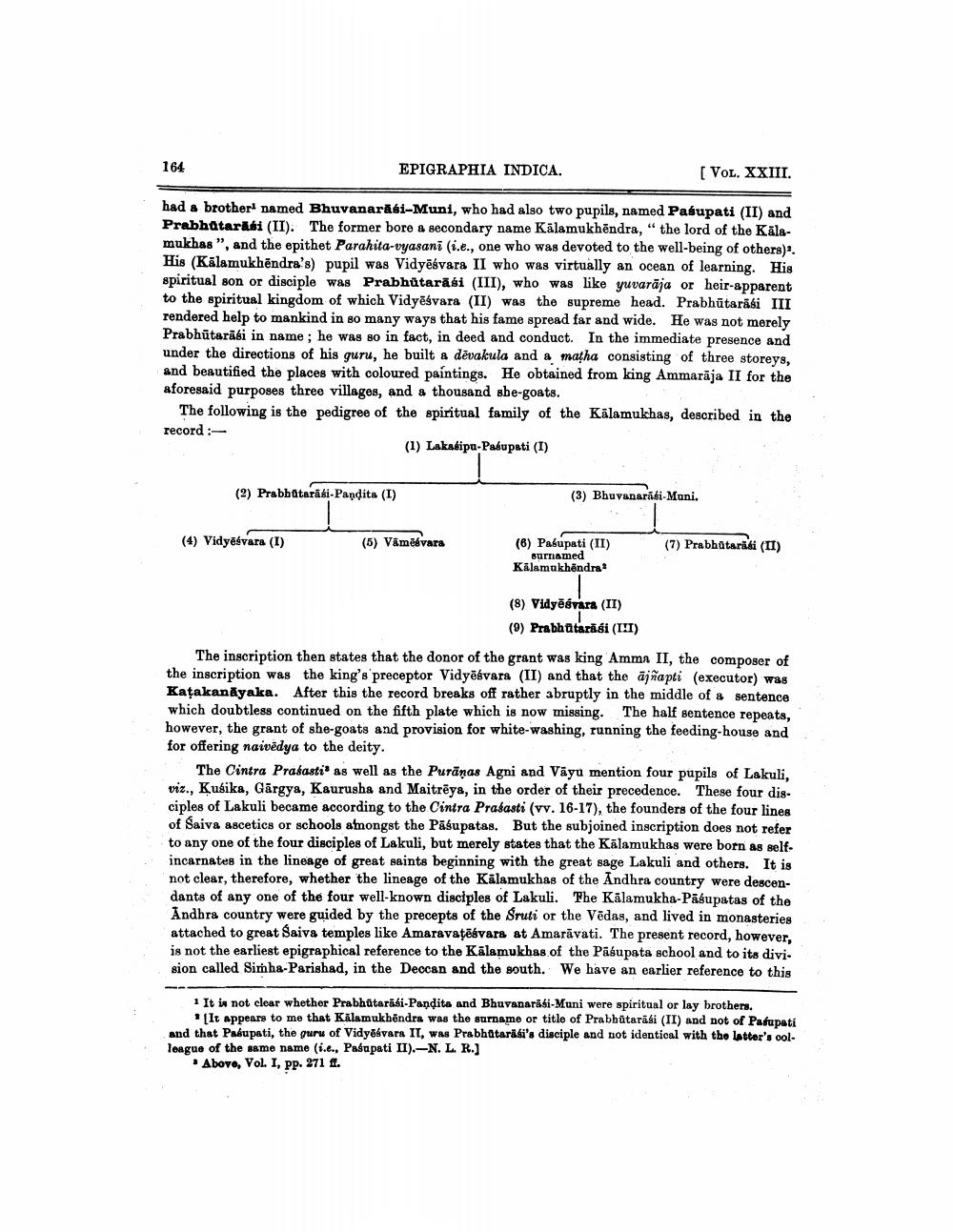________________
164
EPIGRAPHIA INDICA.
[VOL. XXIII.
had a brother named Bhuvanarasi-Muni, who had also two pupils, named Pabupati (II) and Prabhatarisi (II). The former bore a secondary name Kālamukhēndra," the lord of the Kālsmukhas", and the epithet Parahita-vyasani (i.e., one who was devoted to the well-being of others). His (Kālamukhēndra's) pupil was Vidyēsvara II who was virtually an ocean of learning. His spiritual son or disciple was Prabhūtarāśi (III), who was like yuvarāja or heir-apparent to the spiritual kingdom of which Vidyēsvara (II) was the supreme head. Prabhūtarāśi III rendered help to mankind in so many ways that his fame spread far and wide. He was not merely Prabhūtarabi in name; he was so in fact, in deed and conduct. In the immediate presence and under the directions of his guru, he built a dēvakula and a matha consisting of three storeys, and beautified the places with coloured paintings. He obtained from king Ammarāja II for the aforesaid purposes three villages, and a thousand she-goats.
The following is the pedigree of the spiritual family of the Kālamukhas, described in the record :
(1) Lakalipa-Pabupati (I)
(2) Prabhitarasi-Pandita (1)
(3) Bhuvanarati-Muni.
(4) Vidyēsvara (I)
(5) Vimisvara
(7) Prabhatarisi (IT)
(6) Pabupati (IT)
Burnamed Kalamukhēndra
(8) Vidyēsvara (II)
(9) Prabhatarasi (III) The inscription then states that the donor of the grant was king Amma II, the composer of the inscription was the king's preceptor Vidyēśvara (II) and that the ajñapti (executor) was Katakanāyaka. After this the record breaks off rather abruptly in the middle of a sentence which doubtless continued on the fifth plate which is now missing. The half sentence repeats, however, the grant of she-goats and provision for white-washing, running the feeding-house and for offering naivedya to the deity.
The Cintra Prasasti as well as the Purānas Agni and Väyu mention four pupils of Lakuli, viz., Kusika, Gārgya, Kaurusha and Maitrēga, in the order of their precedence. These four dis. ciples of Lakuli became according to the Cintra Prasasti (vv. 16-17), the founders of the four lines of Saiva ascetics or schools amongst the Pasupatas. But the subjoined inscription does not refer to any one of the four disciples of Lakuli, but merely states that the Kālamukhas were born as selfincarnates in the lineage of great saints beginning with the great sage Lakuli and others. It is not clear, therefore, whether the lineage of the Kālamukhas of the Andhra country were descendants of any one of the four well-known disciples of Lakuli. The Kālamukha-Pasupatas of the Andhra country were guided by the precepts of the Sruti or the Vēdas, and lived in monasteries attached to great Saiva temples like Amaravatēsvars at Amarāvati. The present record, however, is not the earliest epigraphical reference to the Kālamukhas of the Pāśupata school and to its divi. sion called Simha Parishad, in the Deccan and the south. We have an earlier reference to this
1 It is not clear whether Prabhūtarasi-Pandita and Bhuvanarasi-Muni were spiritual or lay brothers.
It appears to me that Kalamukhēndra was the surname or title of Prabhūtarasi (II) and not of Pafupati and that Pabupati, the guru of Vidykvars II, was Prabhatarasi's disciple and not identical with the latter's oolleague of the same name (i.e., Pasupati II).-N. L R.)
. Above, Vol. I, pp. 271 ff.




